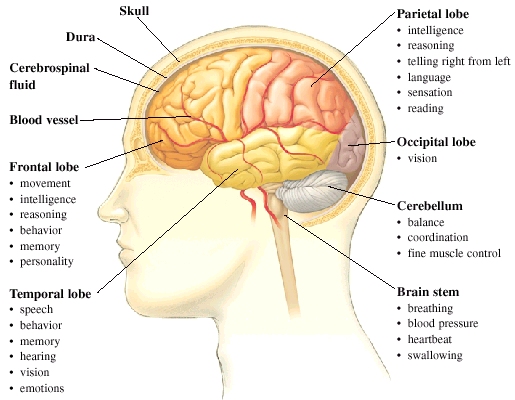Brain Parts And Functions
Cerebrum The is the largest part of the brain. It’s divided into two halves, called hemispheres. The two hemispheres are separated by a groove called the interhemispheric fissure. It’s also called the longitudinal fissure. Each hemisphere of the cerebrum is divided into broad regions called lobes. Each lobe is associated with different functions:. Frontal lobes.
The frontal lobes are the largest of the lobes. As indicated by their name, they’re located in the front part of the brain. They coordinates high-level behaviors, such as motor skills, problem solving, judgment, planning, and attention.
The frontal lobes also manage emotions and impulse control. Parietal lobes. The parietal lobes are located behind the frontal lobes. They’re involved in organizing and interpreting sensory information from other parts of the brain. Temporal lobes. The temporal lobes are located on either side of the head on the same level as the ears.
They coordinate specific functions, including visual memory (such as facial recognition), verbal memory (such as understanding language), and interpreting the emotions and reactions of others. Occipital lobes. The occipital lobes are located in the back of the brain.

They’re heavily involved in the ability to read and recognize printed words, along with other aspects of vision. Cerebellum The is located in the back of the brain, just below the occipital lobes. It’s involved with fine motor skills, which refers to the coordination of smaller, or finer, movements, especially those involving the hands and feet. It also helps the body maintain its posture, equilibrium, and balance. Diencephalon The diencephalon is located at the base of the brain. It contains the:. epithalamus.
The thalamus acts as a kind of relay station for signals coming into the brain. It’s also involved in consciousness, sleep, and memory. The epithalamus serves as a connection between the limbic system and other parts of the brain. The limbic system is a part of the brain that’s involved with emotion, long-term memory, and behavior. The hypothalamus helps maintain homeostasis.
This refers to the balance of all bodily functions. It does this by:. maintaining daily physiological cycles, such as the sleep-wake cycle. controlling appetite. regulating. controlling the producing and release of hormones Brain stem The brain stem is located in front of the cerebellum and connects to the spinal cord.

It consists of three major parts:. Midbrain. The midbrain helps control eye movement and processes visual and auditory information. This is the largest part of the brain stem. It’s located below the midbrain.

It’s a group of nerves that help connect different parts of the brain. The also contains the start of some of the cranial nerves.
These nerves are involved in facial movements and transmitting sensory information. Medulla oblongata. The is the lowest part of the brain. It acts as the control center for the function of the heart and lungs. It helps regulate many important functions, including breathing, sneezing, and swallowing.
Human Brain Parts And Functions
The brain is one of your most important body parts, so it’s important to know how to recognize signs that there may be a problem. Brain injury symptoms Brain injury symptoms depend on the type and severity of the injury. While they sometimes appear immediately after a traumatic event, they can also show up hours or days later. Follow these tips to keep your brain in good health and to reduce your risk of certain brain conditions: Use it or lose it Improve your by regularly reading, learning, or doing activities that make you think, such as crossword puzzles.
All of these help stimulate your nerve cells, and may even lead to the development of new brain cells. Protect your head Always wear a helmet when playing contact sports. Be sure to buckle up when you get in the car. Both of these can go a long way when it comes to avoiding brain injuries. Exercise Doing regular cardio workouts stimulates blood flow throughout your body, including your brain. Quit smoking While smoking is bad for your, it can also lead to cognitive decline. Listen to your thoughts Try to check in from time to time with your thoughts or feelings.
Brain Parts And Functions
Keeping a diary is a good way to get into this habit. Look for any thought patterns or emotions that seem to be impacting your day-to-day life. They could be a sign of an underlying, treatable psychological condition.